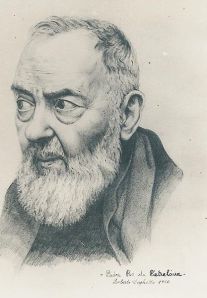Saint Pio (Pius) of Pietrelcina, O.F.M. Cap. (May 25, 1887 – September 23, 1968) was a Capuchin Catholic priest from Italy who is venerated as a saint in the Catholic Church. He was born Francesco Forgione, and given the name Pius (Italian: Pio) when he joined the Capuchins, thus he is popularly known as Padre Pio. He became famous for bearing the stigmata. On 16 June 2002, he was canonized by Pope John Paul II.
Padre Pio was said to have had the gift of reading souls, the ability to bilocate (according to eyewitness accounts), among other supernatural phenomena. The reports of supernatural phenomena surrounding Padre Pio attracted fame and legend. Even the Vatican was initially skeptical.
On the day of Padre Pio’s death, mystic and Servant of God Maria Esperanza de Bianchini from Venezuela reported that he appeared to her in a vision and said, “I have come to say good-bye. My time has come. It is your turn.” Her husband then watched as his wife’s face transfigured into that of Padre Pio. On the following day, they heard of the death of Padre Pio. Witnesses say they later saw Esperanza herself levitating during Mass and engaging in bilocation. Padre Domenico da Cese, a fellow Capuchin stigmatist, reported that on Sunday, September 22, 1968 he saw Padre Pio kneeling in prayer before the Holy Face of Manoppello, although it was known that Padre Pio hadn’t left his room.
On 20 September 1918, while hearing confessions, Padre Pio had his first occurrence of the stigmata: bodily marks, pain, and bleeding in locations corresponding to the crucifixion wounds of Jesus Christ. This phenomenon continued for fifty years, until the end of his life. The blood flowing from the stigmata smelled of perfume or flowers, a phenomenon mentioned in stories of the lives of several saints and often referred to as the odour of sanctity.
His stigmata, regarded as evidence of holiness, was studied by physicians whose independence from the Church is not known. The observations were unexplainable and the wounds never became infected. His wounds healed once but reappeared. They were examined by Luigi Romanelli, chief physician of the City Hospital of Barletta, for about one year. Dr. Giorgio Festa, a private practitioner, also examined them in 1920 and 1925. ProfessorGiuseppe Bastianelli, physician to Pope Benedict XV, agreed that the wounds existed but made no other comment. Pathologist Dr. Amico Bignami of theUniversity of Rome also observed the wounds but could make no diagnosis. Both Bignami and Dr. Giuseppe Sala commented on the unusually smooth edges of the wounds and lack of edema. Dr. Alberto Caserta took X-rays of Padre Pio’s hands in 1954 and found no abnormality in the bone structure.
However, this condition is said to have caused him great embarrassment, and most photographs show him with red mittens or black coverings on his hands and feet where the bleeding occurred. At the time of Padre Pio’s death, his body appeared unwounded, with no sign of scarring. There was a report that doctors who examined his body found it empty of all blood.
Those, both religious and non-religious, who have accused Padre Pio of faking his stigmata, say Padre Pio used carbolic acid to self-inflict the wounds. The sole piece of evidence for this is a single document found in the Vatican’s archive — the report of pharmacist Maria De Vito, from whom he requested 4 grams of the acid. This letter was among the material gathered by those who disputed Padre Pio’s stigmata at the time. According to De Vito, Padre Pio asked her to keep the order secret, saying it was to sterilize needles (he also asked for other things, such as Valda pastilles). One commentator expressed the belief that the Church likely dismissed the claims based on witnesses who stated the acid was in fact used for sterilization. “The boys had needed injections to fight the Spanish Flu which was raging at that time. Due to a shortage of doctors, Padres Paolino and Pio administered the shots, using carbolic acid as a sterilizing agent.” Furthermore, carbolic acid is a chloric substance that causes rotting of the flesh and eats away at biological tissue, which was not consistent with Pio’s wounds which were localized for over sixty years.

[…] Padre Pio (wbonner0.wordpress.com) […]